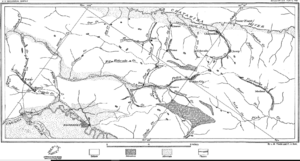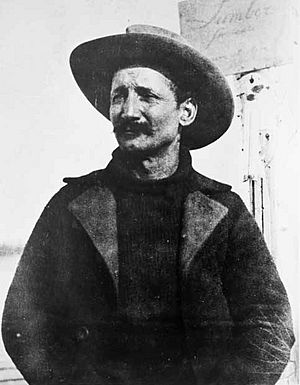Fairbanks Gold Rush facts for kids
The Fairbanks Gold Rush was an exciting time when many people rushed to Fairbanks, Alaska, hoping to find gold. This happened in the early 1900s. Fairbanks grew into a big city because of all the excitement and hard work during this gold rush. Even today, people still look for gold and explore the land around Fairbanks.
Discovering Gold in Fairbanks
A miner named Felix Pedro spent many years searching for gold. He explored the creeks and valleys of the Tanana Valley, which is where Fairbanks is today. He was looking for a new "American Klondike" – a place rich with gold, like the famous Klondike area.
In August 1901, a trader named E.T. Barnette and his wife, Isabelle, were traveling on a riverboat called Lavelle Young. They wanted to set up a trading post further down the Tanana River. However, the water level was too low. The boat could not go any further.
The boat's captain, Charles Adams, decided to turn into the Chena River. This river flows into the Tanana. But the Chena River was also too shallow. So, the Barnettes had to stop there and set up their trading post.
How the Gold Rush Started
Barnette opened his trading post on the Chena River. Felix Pedro soon told Barnette that he had found some promising signs of gold nearby.
Then, on July 22, 1902, Pedro made a big discovery! He found gold north of Fairbanks in Interior Alaska. This discovery officially started the Fairbanks Gold Rush. It caused a huge rush of people to the area, changing the small settlement into a busy town.
Barnette quickly sent a Japanese immigrant named Jujiro Wada to Dawson City. Wada's job was to spread the news about the gold discovery. Barnette wanted many miners to come to Fairbanks so he could sell his goods to them.
After Wada shared the news, many miners who had not gone to the Nome Gold Rush traveled to Fairbanks. These prospectors soon found work. They helped Barnette by panning and sluicing for gold in the Fairbanks area.
Gold Mining After the Rush
Later, a large company called the Fairbanks Exploration Company bought up many mining claims. These claims covered an area about 30 by 50 miles. The company brought in huge gold dredges using the Alaska Railroad. Gold dredges are like giant floating factories that dig up riverbeds to find gold.
Because of all this mining activity, the population of Fairbanks grew. It went from 1,155 people in 1920 to 2,101 people in 1930.
However, once the dredges finished their work, Fairbanks became smaller again. The large dredges were left behind where they stopped working. They are still there today, preserved in the dry, cold air.
On July 22, 1910, about eight years after he found gold, Felix Pedro passed away. He died at St. Joseph's Hospital in Fairbanks.



